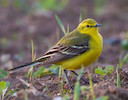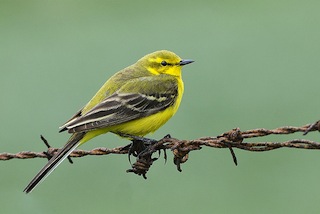 Yellow Wagtails are summer visitors to eastern and northern parts of Britain. They can be spotted in the southwest on migration as they return to their winter home in Africa.
Yellow Wagtails are summer visitors to eastern and northern parts of Britain. They can be spotted in the southwest on migration as they return to their winter home in Africa.
Photo: © Natural England/Allan Drewitt
Scientific name: Motacilla flava
Other common names: Western Yellow Wagtail, British Yellow Wagtail
Conservation status: UK Birds of Conservation Concern, Red; IUCN Red List, Least Concern
What to look for:
- Colouring and appearance: Slender, olive-green above, bright yellow below, black and white tail, yellow face, black wings with two pale bars. Females are duller with browner backs than the males.
- Size: Length 17 cm, wingspan 25 cm.
- Where: Mainly in central and eastern England, eastern Wales and the south of Scotland, but can be spotted in other parts of the country on migration. Their preferred habitats include farmland, upland and wet meadows, and marshes. On migration they will also feed in dry grassland.
- Call: High-pitched psit.
- Similar species: Pied Wagtail, which has black, grey and white colouring; Grey Wagtail, which has a longer tail, a grey back and black wings with single, broad pale wing bar.
 The Yellow Wagtail is a summer visitor to Britain, arriving from Africa in the spring to breed here before returning to its winter home in the autumn. It has the characteristic gait of its cousins, the Pied and Grey Wagtails, running along the ground in darting movements and wagging its tail. It often does this in close proximity to cattle and other livestock, darting about nimbly searching for the insects disturbed by the hooves of the animals.
The Yellow Wagtail is a summer visitor to Britain, arriving from Africa in the spring to breed here before returning to its winter home in the autumn. It has the characteristic gait of its cousins, the Pied and Grey Wagtails, running along the ground in darting movements and wagging its tail. It often does this in close proximity to cattle and other livestock, darting about nimbly searching for the insects disturbed by the hooves of the animals.
Although the Yellow Wagtail doesn’t breed in the southwest, individuals can be spotted in the spring and autumn stopping over on their migration journey. In its breeding territories in other parts of the country, the females lay a clutch of up to six eggs on the ground in long grass in a cup-shaped hair-lined nest. Both male and female share incubation duties, and both share in feeding the young after they have hatched. It is a resident species in the milder climate conditions of more southerly parts of its European and Asian range.
 The Yellow Wagtail’s red listing in the UK is due to a long-term breeding population decline (43% decline between 1995 and 2012), mirroring declines in our resident wagtail populations. Globally, the picture is more complicated, with declines in other European countries partially offset by increases elsewhere. Reasons for declines probably include land drainage and changes in agricultural practice.
The Yellow Wagtail’s red listing in the UK is due to a long-term breeding population decline (43% decline between 1995 and 2012), mirroring declines in our resident wagtail populations. Globally, the picture is more complicated, with declines in other European countries partially offset by increases elsewhere. Reasons for declines probably include land drainage and changes in agricultural practice.
Did you know…?
…The Yellow Wagtail has a complex taxonomy, with 17 recognised sub-species (or races) in the world, of which five have been recorded in Britain. The bird varies in appearance fairly significantly across its global range.
…The races of Yellow Wagtail that breed in the UK nest almost nowhere else globally.
More information and references:
Svensson, L., Mullarney, K., Zetterstrom, D.,1986. Collins Bird Guide, second edition (translated by Christie, D., Svensson, L.). HarperCollins, London.
Published: September 2014
Author: Amanda Scott
Photos: © Natural England/Allan Drewitt (upper photo); © Natural England/Julian Dowse
